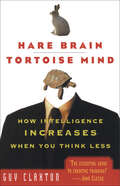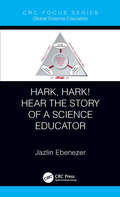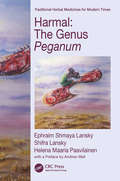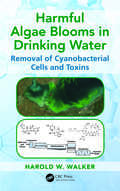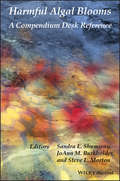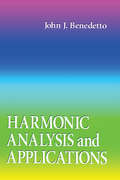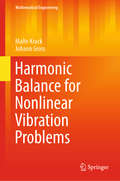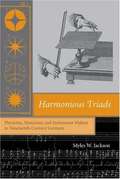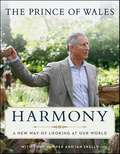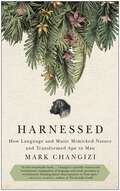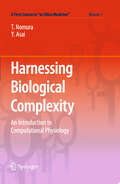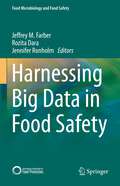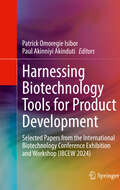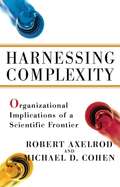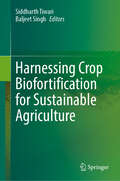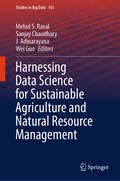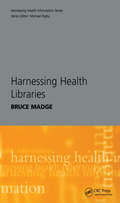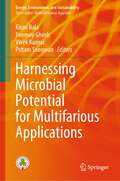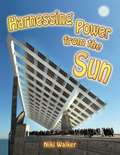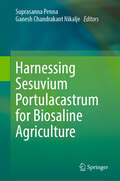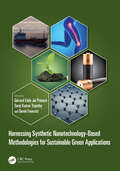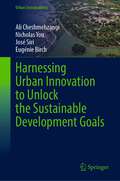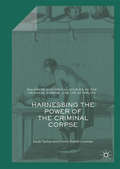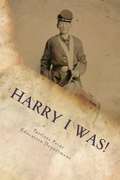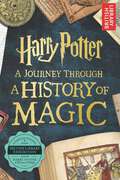- Table View
- List View
Hare Brain, Tortoise Mind: How Intelligence Increases When You Think Less
by Guy Claxton“Backs up anecdotal studies of creativity with up-to-date Information about the latest research into brain function . . . a fascinating book.” —Anthony Storr, author of Solitude: A Return to SelfIn these accelerated times, our decisive and businesslike ways of thinking are unprepared for ambiguity and paradox, and we’ve lost our appreciation for the value of “sleeping on it.” We assume that the quick-thinking hare brain will beat out the slower intuition of the tortoise mind. But new research in cognitive science is changing this understanding of human mental processes. It suggests that patience and confusion—not rigor and certainty—are the essential precursors of wisdom.With a compelling argument that the mind works best when we trust our unconscious, or “undermind,” psychologist Guy Claxton makes an appeal that we be less analytical and let our creativity have free rein. He also encourages reevaluation of society’s obsession with results-oriented thinking and problem-solving under pressure. Packed with interesting anecdotes, a dozen puzzles to test your reasoning, and the latest related research, Hare Brain, Tortoise Mind is an Illuminating, uplifting, stimulating read that focuses on a new kind of well-being and cognition.“The essential guide to creative thinking.” —John Cleese“His multidisciplinary approach is beautifully executed.” —Kirkus Reviews“Counterintuitive . . . provocative . . . While Claxton speaks the language of cognitive science, his ideas resonate with Freud’s description of the unconscious, Buddhist concepts of the divine ground of existence and the great Romantic poets’ notions of the fount of creativity.” —Publishers Weekly
Hark, Hark! Hear the Story of a Science Educator (Global Science Education)
by Jazlin EbenezerHark, Hark! Hear the Story of a Science Educator highlights some compelling ideas on science teaching and learning through the author’s journey and includes evolution and revolution in the growth of scientific knowledge. The book discusses views of McComas et al. and Lederman et al. on the nature of science, as well as the learning theories of Piaget (1926), Vygotsky (1978), and Marton (1981). The three theories of learning frame methods in teaching science. The author is well known in the science education research community for her groundbreaking work in student conceptions and conceptual change, particularly as related to phenomenography. Key Features: Helps science educators explore new avenues related to various innovative curricula, teaching, and learning Presents abstract learning theories, such as social constructivism in personal stories and experiences Bridges the divide between the science education community and the general public on significant ideas of science teaching and learning Uncovers relational conceptual change inquiry learning Discusses current socioscientific community-based issues—other-centeredness—through scientific investigation and engineering design challenges
Harmal: The Genus Peganum (Traditional Herbal Medicines for Modern Times)
by Ephraim Shmaya Lansky Shifra Lansky Helena Maaria PaavilainenHarmal: The Genus Peganum is an in-depth treatment of one of the most commanding plants in the botanical kingdom. Humble in appearance, modest in its needs, Peganum harmala has been venerated for millennia as a Deity-manifesting entheogen and a powerful medicine. This book traverses harmal’s medicinal chemistry, its possible role in the origins of religion, and its employment from ancient times to the present in the therapy of patients suffering from infections, infestations, metabolic derangements, neurological degeneration, visual weakness, and cancer. Its peculiar indolic compounds, known as harmala alkaloids, are now appreciated as exerting profound effects on the mind and on the body. These effects are the result of the alkaloids’ interactions with, and binding to, serotonin receptors on the cell surfaces of neurons in the brain and lymphocytes in the blood, the latter constituting the diffuse structural basis of the immune system. This biphasic modulation by harmala alkaloids has led to a novel pharmacologic re-visioning presented herein for the first time, the concept of a "lymphoneuric syncytium" and its possible long term tuning via "somatodelic" as well as "psychedelic" effects. The scientific rationale underlying the use of harmal in the medicines of the past and the healing technologies of our future is developed through exhaustive and meticulous explorations in both ethnopharmacology and modern phytochemistry. The presentation is enhanced through appraisals of the effects of harmal in two clinical cancer case scenarios, and of intentional inebriation and "provings" by one of the authors and a psychiatric colleague. The noted and esteemed botanically-trained physician Dr. Andrew Weil states in his Preface that this "monumental" volume will become the standard reference work in the field. Harmal: The Genus Peganum will be an invaluable addition to the personal libraries of professional pharmacognosists, botanists, physicians, psychologists, neuroscientists, and all persons interested in the interrelationship of consciousness, medicine, and coevolution.
Harmful Algae Blooms in Drinking Water: Removal of Cyanobacterial Cells and Toxins (Advances in Water and Wastewater Transport and Treatment)
by Harold W. WalkerHarmful algal blooms (HABs) occurring in freshwater, and the associated toxins they produce, are dangerous to animals and humans. The increasing presence of HABs is a major challenge facing water managers and drinking water utilities across the world. This book explores the current research on removal of HABs and toxins from drinking water, and provides the necessary tools so that treatment plant operators, engineers, and water managers can understand the vulnerability of drinking water treatment plants to HABs and develop treatment processes to minimize their impact.
Harmful Algal Blooms: A Compendium Desk Reference
by Sandra E. Shumway JoAnn M. Burkholder Steven L. MortonHarmful Algal Blooms: A Compendium Desk Reference provides basic information on harmful algal blooms (HAB) and references for individuals in need of technical information when faced with unexpected or unknown harmful algal events. Chapters in this volume will provide readers with information on causes of HAB, successful management and monitoring programs, control, prevention, and mitigation strategies, economic consequences of HAB, associated risks to human health, impacts of HAB on food webs and ecosystems, and detailed information on the most common HAB species. Harmful Algal Blooms: A Compendium Desk Reference will be an invaluable resource to managers, newcomers to the field, those who do not have easy or affordable access to scientific literature, and individuals who simply do not know where to begin searching for the information needed, especially when faced with novel and unexpected HAB events. Edited by three of the world's leading harmful algal bloom researchers and with contributions from leading experts, Harmful Algal Blooms: A Compendium Desk Reference will be a key source of information for this increasingly important topic.
Harmonic Analysis and Applications: Mathematics And Applications (Studies In Advanced Mathematics Ser. #23)
by John J. BenedettoHarmonic analysis plays an essential role in understanding a host of engineering, mathematical, and scientific ideas. In Harmonic Analysis and Applications, the analysis and synthesis of functions in terms of harmonics is presented in such a way as to demonstrate the vitality, power, elegance, usefulness, and the intricacy and simplicity of the subject. This book is about classical harmonic analysis - a textbook suitable for students, and an essay and general reference suitable for mathematicians, physicists, and others who use harmonic analysis.Throughout the book, material is provided for an upper level undergraduate course in harmonic analysis and some of its applications. In addition, the advanced material in Harmonic Analysis and Applications is well-suited for graduate courses. The course is outlined in Prologue I. This course material is excellent, not only for students, but also for scientists, mathematicians, and engineers as a general reference. Chapter 1 covers the Fourier analysis of integrable and square integrable (finite energy) functions on R. Chapter 2 of the text covers distribution theory, emphasizing the theory's useful vantage point for dealing with problems and general concepts from engineering, physics, and mathematics. Chapter 3 deals with Fourier series, including the Fourier analysis of finite and infinite sequences, as well as functions defined on finite intervals. The mathematical presentation, insightful perspectives, and numerous well-chosen examples and exercises in Harmonic Analysis and Applications make this book well worth having in your collection.
Harmonic Balance for Nonlinear Vibration Problems (Mathematical Engineering)
by Malte Krack Johann GrossThis monograph presents an introduction to Harmonic Balance for nonlinear vibration problems, covering the theoretical basis, its application to mechanical systems, and its computational implementation. Harmonic Balance is an approximation method for the computation of periodic solutions of nonlinear ordinary and differential-algebraic equations. It outperforms numerical forward integration in terms of computational efficiency often by several orders of magnitude. The method is widely used in the analysis of nonlinear systems, including structures, fluids and electric circuits. The book includes solved exercises which illustrate the advantages of Harmonic Balance over alternative methods as well as its limitations. The target audience primarily comprises graduate and post-graduate students, but the book may also be beneficial for research experts and practitioners in industry.
Harmonious Triads: Physicists, Musicians, and Instrument Makers in Nineteenth-Century Germany
by Myles W. JacksonJackson analyzes the relationship of physicists, musicians, and instrument makers in Germany. Musical instruments provided physicists with experimental systems, and physicists' research led directly to improvements in musical-instrument manufacture and assisted musicians.
Harmony: A New Way of Looking at Our World
by Tony Juniper Ian Skelly The Prince of WalesFor the first time, His Royal Highness Charles, the Prince of Wales, shares his views on how mankind’s most pressing modern challenges are rooted in our disharmony with nature. In the vein of Al Gore’s An Inconvenient Truth and Van Jones’ Green Collar Economy, Prince Charles presents the compelling case that solutions to our most dire crises—from climate change to poverty—lie in regaining a balance with the world around us.
Harnessed: How Language and Music Mimicked Nature and Transformed Ape to Man
by Mark ChangiziThe scientific consensus is that our ability to understand human speech has evolved over hundreds of thousands of years. After all, there are whole portions of the brain devoted to human speech. We learn to understand speech before we can even walk, and can seamlessly absorb enormous amounts of information simply by hearing it. Surely we evolved this capability over thousands of generations. Or did we? Portions of the human brain are also devoted to reading. Children learn to read at a very young age and can seamlessly absorb information even more quickly through reading than through hearing. We know that we didn't evolve to read because reading is only a few thousand years old. In Harnessed, cognitive scientist Mark Changizi demonstrates that human speech has been very specifically &“designed" to harness the sounds of nature, sounds we've evolved over millions of years to readily understand. Long before humans evolved, mammals have learned to interpret the sounds of nature to understand both threats and opportunities. Our speech—regardless of language—is very clearly based on the sounds of nature. Even more fascinating, Changizi shows that music itself is based on natural sounds. Music—seemingly one of the most human of inventions—is literally built on sounds and patterns of sound that have existed since the beginning of time. From Library Journal: "Many scientists believe that the human brain's capacity for language is innate, that the brain is actually "hard-wired" for this higher-level functionality. But theoretical neurobiologist Changizi (director of human cognition, 2AI Labs; The Vision Revolution) brilliantly challenges this view, claiming that language (and music) are neither innate nor instinctual to the brain but evolved culturally to take advantage of what the most ancient aspect of our brain does best: process the sounds of nature ... it will certainly intrigue evolutionary biologists, linguists, and cultural anthropologists and is strongly recommended for libraries that have Changizi's previous book." From Forbes: &“In his latest book, Harnessed, neuroscientist Mark Changizi manages to accomplish the extraordinary: he says something compellingly new about evolution.… Instead of tackling evolution from the usual position and become mired in the usual arguments, he focuses on one aspect of the larger story so central to who we are, it may very well overshadow all others except the origin of life itself: communication."
Harnessing Biological Complexity
by Masao Tanaka Taishin Nomura Yoshiyuki AsaiThe challenge for the biosciences in the twenty-first century is to integrate genome sequencing information into a better understanding of biology, physiology, and human pathology. Such attempts at integration are moving the world toward a new generation of bioscience and bioengineering, where biological, physiological, and pathological information from humans and other living animals can be quantitatively described in silico across multiple scales of time and size and through diverse hierarchies of organization -- from molecules to cells and organs, to individuals. To "harness" such complexity, international communities of integrative bioscientists and bioengineers aim to establish frameworks and information infrastructures for describing biological structures and physiological functions on multiple scales of time and space. This textbook includes a public platform to describe physiological functions using mathematical equations and guides the reader to perform mathematical modeling and computer simulations, to combine existing models as well as to create new models. Accessible to biologists, physiologists, and students of the sciences, with illustrative details provided when necessary, this book seeks to achieve a systematic way of harnessing biological complexity. Sharing the databases among communities worldwide will help to find comprehensive answers to all the important questions.
Harnessing Big Data in Food Safety (Food Microbiology and Food Safety)
by Jeffrey M. Farber Rozita Dara Jennifer RonholmBig Data technologies have the potential to revolutionize the agriculture sector, in particular food safety and quality practices. This book is designed to provide a foundational understanding of various applications of Big Data in Food Safety. Big Data requires the use of sophisticated approaches for cleaning, processing and extracting useful information to improve decision-making. The contributed volume reviews some of these approaches and algorithms in the context of real-world food safety studies. Food safety and quality related data are being generated in large volumes and from a variety of sources such as farms, processors, retailers, government organizations, and other industries. The editors have included examples of how big data can be used in the fields of bacteriology, virology and mycology to improve food safety. Additional chapters detail how the big data sources are aggregated and used in food safety and quality areas such as food spoilage and quality deterioration along the supply chain, food supply chain traceability, as well as policy and regulations. The volume also contains solutions to address standardization, data interoperability, and other data governance and data related technical challenges. Furthermore, this volume discusses how the application of machine-learning has successfully improved the speed and/or accuracy of many processes in the food supply chain, and also discusses some of the inherent challenges. Included in this volume as well is a practical example of the digital transformation that happened in Dubai, with a particular emphasis on how data is enabling better decision-making in food safety. To complete this volume, researchers discuss how although big data is and will continue to be a major disruptor in the area of food safety, it also raises some important questions with regards to issues such as security/privacy, data control and data governance, all of which must be carefully considered by governments and law makers.
Harnessing Biotechnology Tools for Product Development: Selected Papers from the International Biotechnology Conference Exhibition and Workshop (IBCEW 2024)
by Patrick Omoregie Isibor Paul Akinniyi AkindutiThis comprehensive guide that explores the application of biotechnology in creating innovative products across various industries for sustainable development in Nigeria, Africa, and globally. The book delves into the latest biotechnological techniques and tools, including genetic engineering, bioinformatics, and synthetic biology, highlighting their practical uses in pharmaceuticals, agriculture, environmental management, and industrial processes. It will give researchers, practitioners, and students a thorough understanding of how they can leverage biotechnology to drive product innovation, improve efficiency, and address global challenges. Case studies and real-world examples illustrate the potential and impact of biotechnology in modern product development. Provides an in-depth understanding of the latest biotechnology tools and techniques; Examines how biotechnology is used to address global issues like food security, environmental sustainability, and health; Examples and case studies offer insights into successful product development using biotechnological methods.
Harnessing Complexity
by Robert Axelrod Michael D CohenRecent advances in the study of complexity have given scientists profound new insights into how natural innovation occurs and how its power can be exploited. Now two pioneers in the field, Robert Axelrod and Michael D. Cohen, provide leaders in business and government with a guide to complexity that will help them make effective decisions in a world of rapid change. Building on evolutionary biology, computer science, and social design, Axelrod and Cohen have constructed a unique framework for improving the way people work together. Their approach to management is based on the concept of the Complex Adaptive System, which can describe everything from rain forests to the human gene pool, and from automated software agents to multinational companies. The authors' framework reveals three qualities that all kinds of managers must cultivate in their organization: Variation What is the best way to manage the development of software? Should the problem be broken up into small pieces for programmers working independently, thus enhancing variation, or should there be a centralized hierarchy of programmers ruled by a chain of command? The authors show how the decentralized creation of variation combined with the centralized maintenance of standards was the key to the success of the Linux "open source software" project, which brought together thousands of volunteers in cyberspace to produce an operating system that can outperform Microsoft's. Interaction Why did northern Italy prosper while southern Italy remained poor? Recognizing the internal interactions of a Complex Adaptive System -- be it a national region, a company, or a nonprofit group -- reveals vital networks of trust. Axelrod and Cohen explain that in successful adaptive systems, rich networks of horizontal linkages foster cooperation and provide an advantage over other less cooperatively networked groups. In the case of Italy, voluntary associations created networks of trust in the Middle Ages that became northern Italy's critical advantage over the south. Selection Is a Pulitzer Prize better than a National Book Award? How can foundations and corporations design competitions that have a positive effect on the evolution of excellence? The authors' framework makes clear that the worst selection processes are mired in orthodox standards that have not adapted to a new environment. The best selection processes, on the other hand, are created and run by leaders who understand how the standards they use can transform their organization and its environment. This simple, paradigm-shifting analysis of how people work together will transform the way we think about getting things done in a group. Harnessing Complexity is the essential guide to creating wealth, power, and knowledge in the 21st century.
Harnessing Crop Biofortification for Sustainable Agriculture
by Siddharth Tiwari Baljeet SinghThis edited volume provides insights into the current state of food and nutritional security, highlights the significance of micronutrients for human health, offers a historical perspective on biofortification, and covers current strategies and challenges. This book explores the role of multidisciplinary approaches to cope up with the challenges of major nutrient deficiency. Hidden hunger (aka micronutrient deficiencies), a prevalent global issue, refers to the chronic deficiency of essential micronutrients despite sufficient caloric intake. With over 2 billion affected individuals, particularly women and children in low-income countries, it impairs physical and cognitive development, increases disease susceptibility, and diminishes productivity. Despite economic progress, undernourishment remains prevalent in the developing countries including India. Among all nutrients, the deficiencies of iron, zinc, iodine, and vitamin A are highly prevalent. Crop biofortification seems a sustainable solution to reduce the global burden of hidden hunger. Previous reports examined the genetic diversity related to micronutrients in germplasm of staple crops and their wild relatives. A number of biofortified crops have been developed by utilizing genetic diversity and biotechnological approaches. This book explores crop-specific biofortification initiatives and diverse approaches, encompassing both traditional and genomics-driven enhancements. It also enlightens the efficacy of biofortification, bioavailability, and future thrust. This book serves as a valuable resource for researchers, academics, extension workers, policymakers, students, and all those involved in agriculture, nutrition, and health. It focuses on promoting diets that are rich in nutrition, benefiting everyone along the value chain.
Harnessing Data Science for Sustainable Agriculture and Natural Resource Management (Studies in Big Data #161)
by Sanjay Chaudhary Mehul S. Raval Wei Guo J. AdinarayanaThis book is a comprehensive resource that handles the issues of sustainable agriculture and natural resource management, aligned with the United Nations' Sustainable Development Goals (SDGs). The book is organized into five sections, Understanding the Problem, Data Collection and Cleaning, Exploratory Data Analysis and Visualization, Model Building, and Model Deployment. Each section covers a critical aspect of data science in this context and addresses specific SDGs 2—zero hunger, 6—clean water and sanitation, 12—responsible consumption and production, 13—climate action, and 15—Life on land. The organized sections are arranged to seamlessly follow the data science pipeline and provide practical guidance from problem understanding to its model deployment and stakeholder management. The book is useful for researchers, students, practitioners, and policymakers.
Harnessing Health Libraries
by Bruce MadgeThe rise of evidence-based healthcare has put emphasis on finding specific evidence. Trying to find exactly the right article you are looking for can be vital especially when meeting a tight deadline or trying to find evidence for a particular treatment. This book from the Harnessing Health Information series shows the reader how to find the exact article quickly and efficiently. Fully referenced, it includes handy information such as acronyms with full descriptions and the available search tools. It looks at how novice users can find information in a straightforward and friendly way.
Harnessing Microbial Potential for Multifarious Applications (Energy, Environment, and Sustainability)
by Vivek Kumar Kiran Bala Tonmoy Ghosh Pritam SangwanThis book discusses the current state of strategies that utilize the ability of microbes to remediate waste sources, such as wastewater streams and mine tails, and provide environmentally friendly options to mitigate soil and water pollution caused due to heavy metals. It also provides details about the development of biodegradable plastics from microbial sources and how they can be economical and greener alternatives to the currently used options. It will act as a single platform for combining the remedial powers of microbes which can be both sustainable and practical under a single volume. This text will be particularly useful for govt. institutions, academicians, and industry professionals, who deal in wastewater remediation and sustainability of currently used sources of plastics and other high-value metabolites. It will also be of practical help to engineers involved in remediation processes for wastewater and industrial waste.
Harnessing Power from the Sun
by Niki WalkerThe oldest and most important source of power for our planet is the Sun. This amazing new book explains why solar power is becoming a very real replacement for our current energy sources. Detailed images feature different types of solar collectors, solar thermal plants, and solar cells, and help explain how they are used. Special case studies identify areas where solar power is already in use around the world.
Harnessing Sesuvium Portulacastrum for Biosaline Agriculture
by Suprasanna Penna Ganesh Chandrakant NikaljeThis edited book provides a detailed and comprehensive overview of the stress adaptation and utilization of the halophyte Sesuvium portulacastrum in bio-saline agriculture. The book focuses on plant's defense mechanisms to various abiotic stresses, including salt, drought, toxic metals, dyes, effluents, and nutrient deficiency. The book highlights the potential applications of S. portulacastrum in environmental protection, such as, desalination, and phytoremediation. One of the key features of the book is its exploration of the adaptation mechanisms of S. portulacastrum to environmental stresses at morphological, anatomical, physiological, biochemical, molecular, proteomic, and metabolomic levels. This in-depth analysis provides a comprehensive understanding of how Sesuvium withstands harsh environments and, this could potentially serve as a model for investigations on other plants and in developing salt tolerant plants. The book also provides directions for utilizing S. portulacastrum in bio-saline agriculture. The book is a valuable resource for researchers, agronomists, and policymakers interested in developing sustainable agriculture practices in regions affected by salinity and other environmental stresses.
Harnessing Synthetic Nanotechnology-Based Methodologies for Sustainable Green Applications
by Gérrard Eddy Jai Poinern, Suraj Kumar Tripathy and Derek FawcettNanotechnology is at the forefront of many of the latest developments across science and technology, but to generate and deploy these applications, macroscopic levels of nanoscale materials have to be carefully generated whilst remaining cost effective. These materials need to be reliable, consistent, and safe, and as a general principle, industries should consider green sustainable methods in the synthesis of these material and their applications as well. This book introduces readers to the field of green nanotechnologies and their possible applications to create a safer world. This accessible and practical guide will be a useful resource for material scientists, engineers, chemists, biotechnologists, and scientists working in the space of nanomaterials, in addition to graduate students in physics, chemistry, biomedical sciences and engineering. THIS BOOK Presents an accessible introduction to the topic in addition to more advanced material for specialists in the field. Covers a broad spectrum of topics in this new field. Contains exciting case studies and examples, such as quantum dots, bionanomaterials, and future perspectives. Dr Gérrard E.J. Poinern holds a Ph.D. in Physics from Murdoch University, Western Australia and a Double Major in Physics and Chemistry. Currently he is an Associate Professor in Physics and Nanotechnology in the School of Engineering and Information Technology at Murdoch University. He is the director of Murdoch Applied Innovation and Nanotechnology Research Group, Murdoch University. In 2003, he discovered and pioneered the use of an inorganic nanomembrane for potential skin tissue engineering applications. He is the recipient of a Gates Foundation Global Health Grand Challenge Exploration Award for his work in the development of biosynthetic materials and their subsequent application in the manufacture of biomedical devices. He is also the author of the 2014 CRC Press experimental textbook "A Laboratory Course in Nanoscience and Nanotechnology". Associate Professor Suraj Kumar Tripathy is Associate Dean of the School of Chemical Technology at Kalinga Institute of Industrial Technology, Bhubaneswar, India. He currently leads the Chemical & Bioprocess Engineering Lab (CBEL) at KIIT which focuses on achieving sustainability in materials processing and utilization. CBEL explores opportunities in valorization of waste materials (secondary resources) and investigate their applications in catalysis, water treatment, and biomedical systems. CBEL also works closely with industries to develop suitable waste management and resource recycling strategies to optimize the potential of circular economy model. Dr. Derek Fawcett is the Defence Science Centre research fellow at Murdoch University, Australia. His research involves the investigation and development of new advanced materials and their use in innovative engineering systems. He has published over seventy peer-reviewed research papers in international journals and is the co-author of four book chapters on applied nanotechnology.
Harnessing Urban Innovation to Unlock the Sustainable Development Goals (Urban Sustainability)
by Ali Cheshmehzangi Nicholas You José Siri Eugénie BirchThis book first attempts to explore the nexus between urban innovation and sustainable development goals (SDGs). It puts together global examples of urban innovation initiatives, highlighting practical, policy-oriented, social, and technological interventions. The case studies are divided into four clusters of ‘green cities’, ‘inclusive cities’, ‘resilient cities’, and ‘healthy cities’. In doing so, the book maps various global examples of urban innovation for sustainable pathways and directions. It also highlights means of implementation of tool and technologies, data, financing, and governance. The overarching aim is to provide a holistic overview of urban innovation sustainable development nexus, which would help future policy development, paradigm shifts, and technological applications.By summarising a selection of successful initiatives, interventions, and projects, this book highlights how urban innovation could accelerate achieving SDGs. The lessons learned from each case study cluster are narrated as knowledge transfer platforms for future city development and achieving sustainable development. These lessons will be beneficial to practitioners and governments, as well as researchers and academics who are interested in urban innovation research. City case studies included in the book are based on their success stories as role models for other cities in developed and developing nations. This collection helps us portray a more holistic image of urban innovation aligned with the SDGs and pathways to achieving them.
Harnessing the Power of the Criminal Corpse (Palgrave Historical Studies In The Criminal Corpse And Its Afterlife Ser.)
by Sarah Tarlow Emma Battell LowmanThis open access book is the culmination of many years of research on what happened to the bodies of executed criminals in the past. Focusing on the eighteenth and nineteenth centuries, it looks at the consequences of the 1752 Murder Act. These criminal bodies had a crucial role in the history of medicine, and the history of crime, and great symbolic resonance in literature and popular culture. Starting with a consideration of the criminal corpse in the medieval and early modern periods, chapters go on to review the histories of criminal justice, of medical history and of gibbeting under the Murder Act, and ends with some discussion of the afterlives of the corpse, in literature, folklore and in contemporary medical ethics. Using sophisticated insights from cultural history, archaeology, literature, philosophy and ethics as well as medical and crime history, this book is a uniquely interdisciplinary take on a fascinating historical phenomenon.
Harry I Was?!
by Patriots Point Education DepartmentJoin Harry Smith and his family as they experience truly historic events in American history. These stories and letters take you on a journey through important events from the Civil War through the Space Race!
Harry Potter - A Journey Through A History of Magic
by British British LibraryHarry Potter: A History of Magic is the official companion eBook to the special exhibition Harry Potter: A History of Magic that ran at the British Library in 2017 and New-York Historical Society in 2018. Explore the extraordinary subjects of the Hogwarts curriculum - Potions & Alchemy, Divination, Care of Magical Creatures, and more - and examine incredible historical artifacts, items from J.K. Rowling's personal archive, and stunning original artwork from Harry Potter series artists Mary GrandPré, Jim Kay, and Brian Selznick. This complete catalogue of the over 150 artifacts on display gives readers an up-close look at magical treasures from all over the world, and their inspiration on J.K. Rowling's magical inventions. Readers will be able to pore over ancient spell books, explore amazing illuminated scrolls that reveal the secret of the Elixir of Life, and through its unique design and functionality examine vials of dragon's blood, mandrake roots, painted centaurs and a genuine witch's broomstick. This special publication is an essential volume for all Harry Potter fans, history buffs, bibliophiles, and is a fascinating exploration of the history of the magic at the heart of the Harry Potter stories.
